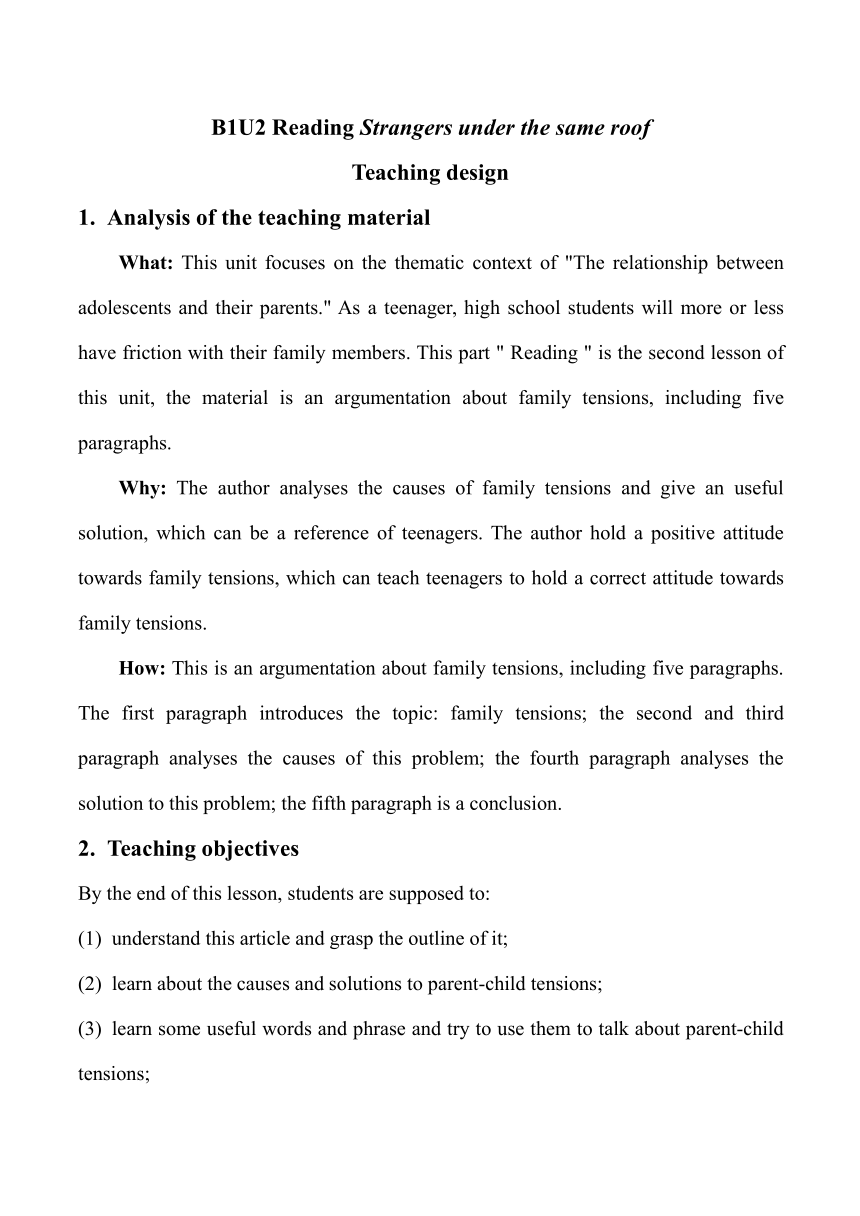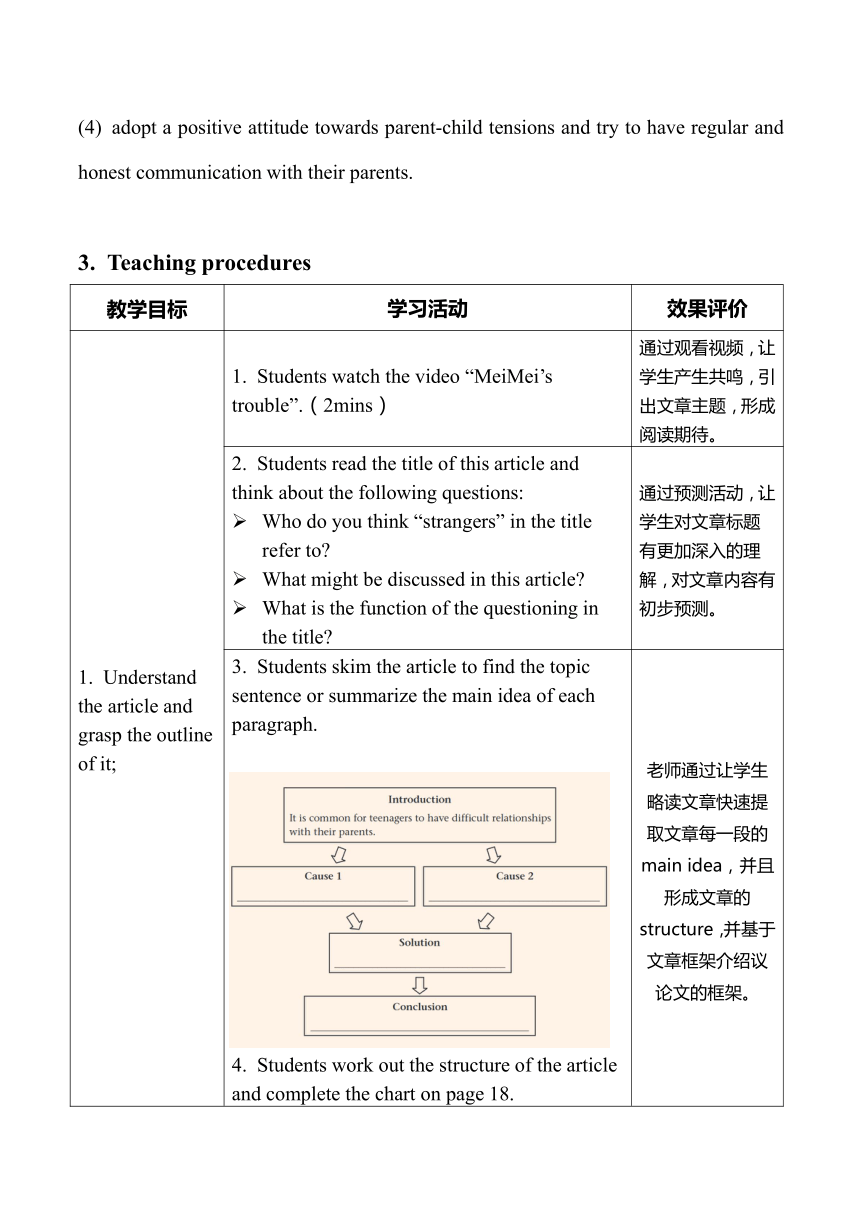牛津译林版(2020)必修第一册Unit 2 Let's talk teens Reading 教学设计
文档属性
| 名称 | 牛津译林版(2020)必修第一册Unit 2 Let's talk teens Reading 教学设计 |

|
|
| 格式 | docx | ||
| 文件大小 | 103.3KB | ||
| 资源类型 | 教案 | ||
| 版本资源 | 牛津译林版 | ||
| 科目 | 英语 | ||
| 更新时间 | 2024-10-31 17:29:38 | ||
图片预览


文档简介
B1U2 Reading Strangers under the same roof
Teaching design
Analysis of the teaching material
What: This unit focuses on the thematic context of "The relationship between adolescents and their parents." As a teenager, high school students will more or less have friction with their family members. This part " Reading " is the second lesson of this unit, the material is an argumentation about family tensions, including five paragraphs.
Why: The author analyses the causes of family tensions and give an useful solution, which can be a reference of teenagers. The author hold a positive attitude towards family tensions, which can teach teenagers to hold a correct attitude towards family tensions.
How: This is an argumentation about family tensions, including five paragraphs. The first paragraph introduces the topic: family tensions; the second and third paragraph analyses the causes of this problem; the fourth paragraph analyses the solution to this problem; the fifth paragraph is a conclusion.
Teaching objectives
By the end of this lesson, students are supposed to:
understand this article and grasp the outline of it;
learn about the causes and solutions to parent-child tensions;
learn some useful words and phrase and try to use them to talk about parent-child tensions;
adopt a positive attitude towards parent-child tensions and try to have regular and honest communication with their parents.
Teaching procedures
教学目标 学习活动 效果评价
Understand the article and grasp the outline of it; Students watch the video “MeiMei’s trouble”.(2mins) 通过观看视频,让学生产生共鸣,引出文章主题,形成阅读期待。
Students read the title of this article and think about the following questions: Who do you think “strangers” in the title refer to What might be discussed in this article What is the function of the questioning in the title 通过预测活动,让学生对文章标题有更加深入的理解,对文章内容有初步预测。
Students skim the article to find the topic sentence or summarize the main idea of each paragraph. Students work out the structure of the article and complete the chart on page 18. Based on the structure of this article, teacher introduces that this article is a typical argumentation and shows the basic composition of an argumentation. 老师通过让学生略读文章快速提取文章每一段的main idea,并且形成文章的structure,并基于文章框架介绍议论文的框架。
设计意图:After watching the video, students identify with MeiMei and are triggered to wonder the reasons and solutions of family tensions. Students work out the main ideas of each paragraph and learn to use the chart to grasp the structure of the article.
Learn about the causes and solutions to parent-child tensions; Students read para.1 and answer the following questions: Who are the targeted readers of this article What are the two forms of common parent-child tension What does the sentence “You are not alone” mean . Students read para.2 and answer the following questions: What physical changes might teenagers worry about How do these physical changes result in family tensions Students read para.3 and think about: What does “a strange middle ground” mean Then students fill in blanks. Students read para 4 and conclude the 4 steps of communication. Students try to use some adjectives to describe what a healthy discussion is like. 教师通过指导学生精读课文,让学生对文章内容有更深入的理解。
设计意图:让学生对文章细节有更深入的理解。
Adopt a positive attitude towards parent-child tensions and try to have regular and honest communication with your parents. Students read para.5 and answer the following questions: What’s is the author’s attitude to parent-child tensions Use information in the magazine article to support your idea. 教师指导学生利用文章内容给MeiMei提出建议。
Learn some useful words and phrase and try to use them to talk about parent-child tensions; MeiMei gets into a fight with her mother because her mother read her diary without permission and put her into a awkward situation. If you were MeiMei's friend, what would you advise her to do Students work in pairs to talk about it.
设计意图:利用课堂导入视频的情境,让学生学以致用。
Teaching design
Analysis of the teaching material
What: This unit focuses on the thematic context of "The relationship between adolescents and their parents." As a teenager, high school students will more or less have friction with their family members. This part " Reading " is the second lesson of this unit, the material is an argumentation about family tensions, including five paragraphs.
Why: The author analyses the causes of family tensions and give an useful solution, which can be a reference of teenagers. The author hold a positive attitude towards family tensions, which can teach teenagers to hold a correct attitude towards family tensions.
How: This is an argumentation about family tensions, including five paragraphs. The first paragraph introduces the topic: family tensions; the second and third paragraph analyses the causes of this problem; the fourth paragraph analyses the solution to this problem; the fifth paragraph is a conclusion.
Teaching objectives
By the end of this lesson, students are supposed to:
understand this article and grasp the outline of it;
learn about the causes and solutions to parent-child tensions;
learn some useful words and phrase and try to use them to talk about parent-child tensions;
adopt a positive attitude towards parent-child tensions and try to have regular and honest communication with their parents.
Teaching procedures
教学目标 学习活动 效果评价
Understand the article and grasp the outline of it; Students watch the video “MeiMei’s trouble”.(2mins) 通过观看视频,让学生产生共鸣,引出文章主题,形成阅读期待。
Students read the title of this article and think about the following questions: Who do you think “strangers” in the title refer to What might be discussed in this article What is the function of the questioning in the title 通过预测活动,让学生对文章标题有更加深入的理解,对文章内容有初步预测。
Students skim the article to find the topic sentence or summarize the main idea of each paragraph. Students work out the structure of the article and complete the chart on page 18. Based on the structure of this article, teacher introduces that this article is a typical argumentation and shows the basic composition of an argumentation. 老师通过让学生略读文章快速提取文章每一段的main idea,并且形成文章的structure,并基于文章框架介绍议论文的框架。
设计意图:After watching the video, students identify with MeiMei and are triggered to wonder the reasons and solutions of family tensions. Students work out the main ideas of each paragraph and learn to use the chart to grasp the structure of the article.
Learn about the causes and solutions to parent-child tensions; Students read para.1 and answer the following questions: Who are the targeted readers of this article What are the two forms of common parent-child tension What does the sentence “You are not alone” mean . Students read para.2 and answer the following questions: What physical changes might teenagers worry about How do these physical changes result in family tensions Students read para.3 and think about: What does “a strange middle ground” mean Then students fill in blanks. Students read para 4 and conclude the 4 steps of communication. Students try to use some adjectives to describe what a healthy discussion is like. 教师通过指导学生精读课文,让学生对文章内容有更深入的理解。
设计意图:让学生对文章细节有更深入的理解。
Adopt a positive attitude towards parent-child tensions and try to have regular and honest communication with your parents. Students read para.5 and answer the following questions: What’s is the author’s attitude to parent-child tensions Use information in the magazine article to support your idea. 教师指导学生利用文章内容给MeiMei提出建议。
Learn some useful words and phrase and try to use them to talk about parent-child tensions; MeiMei gets into a fight with her mother because her mother read her diary without permission and put her into a awkward situation. If you were MeiMei's friend, what would you advise her to do Students work in pairs to talk about it.
设计意图:利用课堂导入视频的情境,让学生学以致用。
